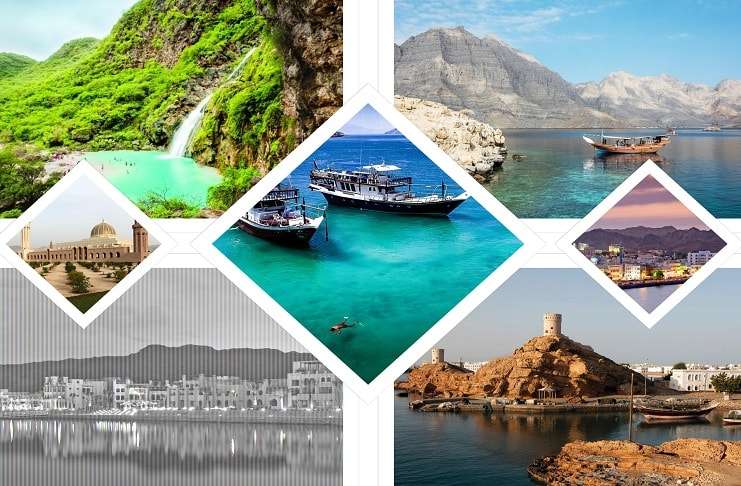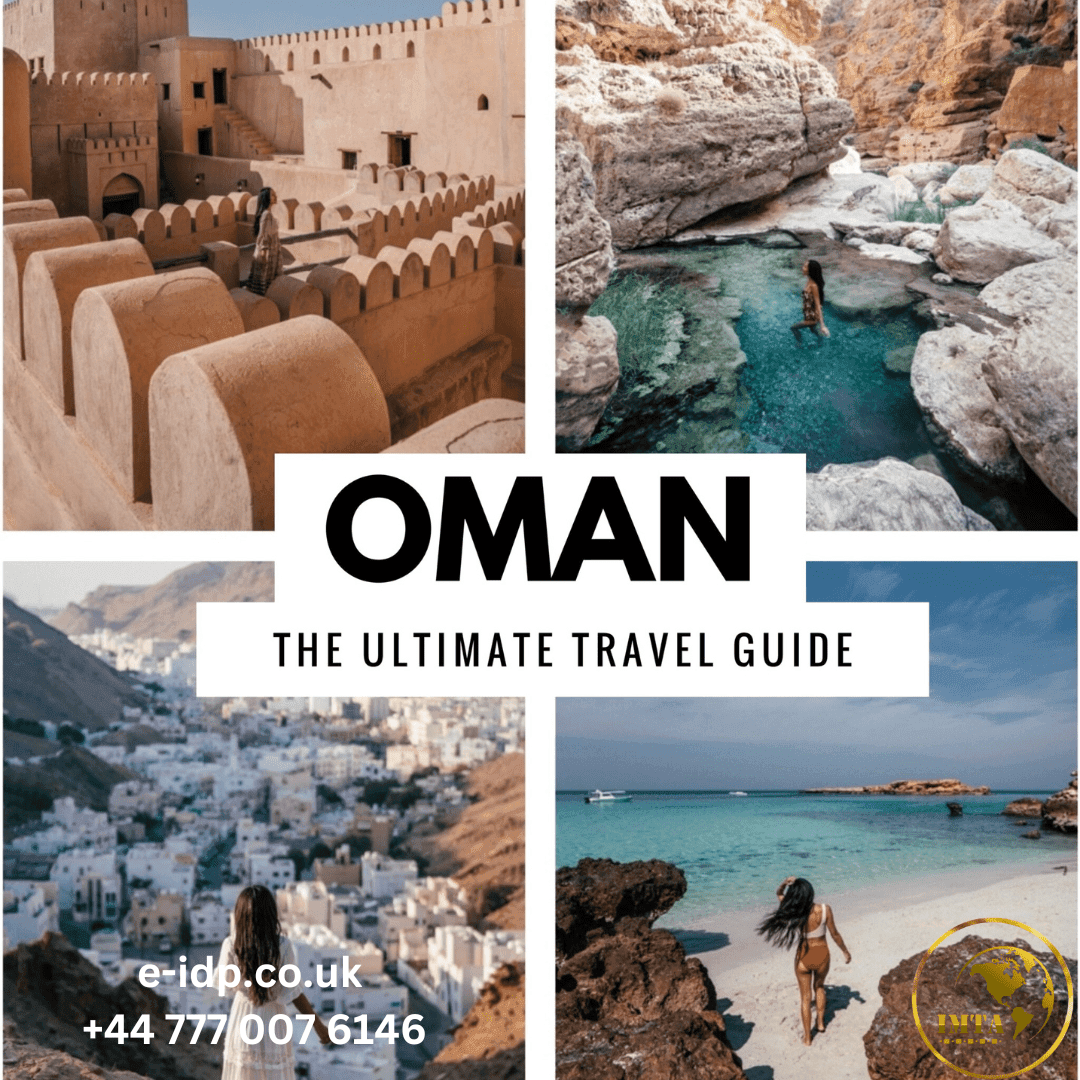Driving Guide To Oman International Drivers Permit
Discovering the stunning landscapes of Oman by car presents a remarkable opportunity to witness the diverse scenery, including deserts, mountains, and coastal areas. To facilitate a seamless and secure journey, it is crucial to familiarize oneself with Oman’s driving regulations, prerequisites, and road conditions. Below is a detailed guide to driving in Oman. Oman driving guide, IDP apply online Oman , International Driving Permit Oman, International Driving licence Oman, International Driving license Oman

1. Driving Requirements in Oman
For Tourists:
– International Driving Permit (IDP): Tourists are permitted to operate a vehicle in Oman provided they possess an IDP in conjunction with a valid driver’s license from their country of origin, which is valid for a duration of up to three months.
– GCC License Holders: Individuals holding a driver’s license from any GCC nation may drive in Oman using that license without the necessity of an IDP.
For Residents:
– Expatriates are required to obtain an Omani driver’s license following the acquisition of their residence visa. Certain expatriates may have the option to convert their licenses from specific countries without undergoing a driving test, while others may be required to complete a driving test. The legal minimum age for driving in Oman is 18 years.
2. Driving Laws and Rules in Oman
Fundamental Traffic Regulations:
– Vehicles must be operated on the right side of the roadway.
– The use of seat belts is compulsory for the driver and all front-seat occupants.
– The use of mobile phones while driving is strictly forbidden unless a hands-free device is employed.
– Children under the age of four are required to be secured in an approved child safety seat.
– Speed restrictions are as follows: 120 km/h on major highways, 90-100 km/h on regional roads, and 40-60 km/h in urban settings. Speed enforcement cameras are prevalent, and speed limits are prominently displayed on signage.
Alcohol Consumption and Driving:
– There is a strict zero-tolerance policy regarding alcohol consumption while operating a vehicle, with a legal blood alcohol concentration limit set at 0.0%. The consequences for driving under the influence are severe, including substantial fines, imprisonment, and potential deportation for foreign nationals.
3. Road Infrastructure
Highways:
– Oman boasts a comprehensive network of modern highways that link key cities such as Muscat, Nizwa, Salalah, and the border with the UAE. The roads are typically of high quality, featuring wide lanes and clear signage in both Arabic and English.
City Roads:
– In major urban centers like Muscat, the roads are well-maintained; however, traffic congestion can occur during peak hours, particularly in the mornings and evenings. Roundabouts are prevalent in cities and towns, with vehicles already within the roundabout having the right of way.
Mountain and Desert Roads:
– In rural regions, especially those that are mountainous or desert-like, one may encounter unpaved or winding roads. In these instances, it is advisable to utilize a 4×4 vehicle.
4. Fuel and Petrol Stations
Fuel prices in Oman are competitive when compared to international rates, and petrol stations are conveniently situated in urban areas and along major highways. Both petrol and diesel are easily accessible, with payment options available in cash or by card.

5. Car Insurance
– Third-party insurance is compulsory in Oman, covering damages to another vehicle in the event of an accident.
– Opting for comprehensive insurance is advisable, particularly when renting a vehicle or driving in more remote areas.
6. Renting a Car in Oman
Car rental services are available in prominent cities and airports. To secure a rental vehicle, the following items are necessary:
– A valid driver’s license (or an International Driving Permit if mandated).
– A passport.
– A credit card for the rental deposit.
– The majority of car rental agencies provide standard vehicles suitable for urban driving as well as 4×4 options for excursions in desert or mountainous regions.
7. Parking in Oman
Locating parking in urban areas such as Muscat is typically straightforward and economical. Numerous shopping centers and public spaces offer complimentary parking, whereas certain city regions feature metered parking options. It is crucial to refrain from parking in designated no-parking zones, as vehicles parked illegally may face fines or towing.
8. Traffic Fines and Violations
Fines for speeding begin at approximately 20 OMR and may increase depending on the seriousness of the violation. Oman utilizes a sophisticated traffic camera system to oversee instances of speeding, red light violations, and other infractions. Payments for these fines can be made online or at the offices of the Royal Oman Police (ROP).
9. Emergency Services and Assistance
In case of an emergency, please call 9999 to connect with the police, fire services, or medical assistance. If you find yourself in an accident resulting in injuries or considerable damage to your vehicle, it is imperative to notify the police without delay.
Roadside assistance is accessible in Oman via insurance companies or private service providers.
10. Driving in Oman: Etiquette and Tips
It is advisable to engage in defensive driving, as Omani drivers may exhibit unpredictable behavior, particularly on highways where rapid speeds and abrupt lane changes are prevalent. Maintaining vigilance and being conscious of your environment is crucial.
When navigating roundabouts, exercise caution, as Omani drivers often approach them at elevated speeds. Always yield to vehicles already within the roundabout and be attentive when merging.
Pedestrian crossings are common, especially in urban settings. It is important to reduce your speed and yield to pedestrians when required.
Driving at night, particularly on rural or desert roads, poses risks due to limited visibility and the possibility of encountering wildlife, such as camels.
Weather Conditions:
Given the extreme heat, particularly in the summer months, ensure that your vehicle’s air conditioning is operational and carry a sufficient amount of water.
In some regions, thick fog can significantly impair visibility, especially during early mornings or winter. Utilize your fog lights and decrease your speed as necessary.
Although infrequent, rain can result in flash floods, particularly in wadis (dry riverbeds) and lower areas. Exercise caution during rainy conditions and refrain from driving through flooded streets.
11. Cross-Border Travel
Oman shares a border with the United Arab Emirates, facilitating the possibility of cross-border driving. It is essential to verify that your rental vehicle is equipped with suitable insurance for such travel and to have all required documentation on hand, including your passport, visa, and driver’s license. Additionally, it is advisable to account for possible delays at the border when planning your journey.
Conclusion
Exploring Oman by car provides an exceptional opportunity to appreciate the nation’s stunning landscapes and cultural landmarks. The presence of well-maintained roads, economical fuel prices, and dependable infrastructure makes road travel an appealing choice for both visitors and locals. To guarantee a safe and pleasant experience, it is crucial to understand the local driving regulations, road conditions, and cultural practices.
What you need to rent a car, and how to rent one
As a tourist, you’ll most likely be renting a car (more on that in a bit) for your road trip. Even so, there are certain requirements that you’ll have to check off before you get into it.
- You have to get an International Driver’s Permit. Apply for it online or head to the office — we prefer doing it in person because the queue is pretty short during off-peak hours, and you can get it done on the same day. It’ll cost S$20 and is valid for one year from the date of issue.
- A valid local driver’s license. international driving licence online
- You have to be at least 21 years of age and have held your local licence for a year. A surcharge may be imposed for drivers under the age of 25.
- A passport for identification .
- A credit card in the driver’s name.
How to obtain an international driving permit

The process of obtaining an international driving license directly from an office can be quite challenging and time-consuming. The payment methods involved can also be complex. Therefore, it is recommended to consider applying for an international driving license from IMTA. The application process only takes around 10 to 15 minutes, making it a more efficient option for getting your international driving permit
The necessary details required for the application of an International driving permit include:
– Full Name
– Email & Phone Number
– Current Address
– Place of Birth
– National Driver’s License Number
– National Driver’s License Issued Date & Expiry Date
– Picture of Driver’s License & Your Head Shot Photo for Your IDP
 Oman driving guide, IDP apply online Oman , International Driving Permit Oman, International Driving licence Oman, International Driving license Oman, Oman driving guide, IDP apply online Oman , International Driving Permit Oman, International Driving licence Oman, International Driving license Oman, Oman driving guide, IDP apply online Oman , International Driving Permit Oman, International Driving licence Oman, International Driving license Oman
Oman driving guide, IDP apply online Oman , International Driving Permit Oman, International Driving licence Oman, International Driving license Oman, Oman driving guide, IDP apply online Oman , International Driving Permit Oman, International Driving licence Oman, International Driving license Oman, Oman driving guide, IDP apply online Oman , International Driving Permit Oman, International Driving licence Oman, International Driving license Oman





